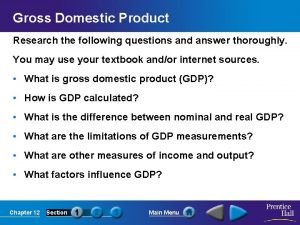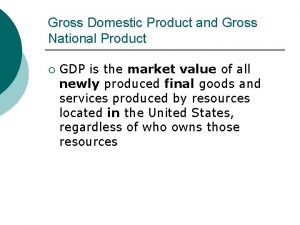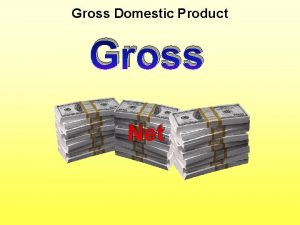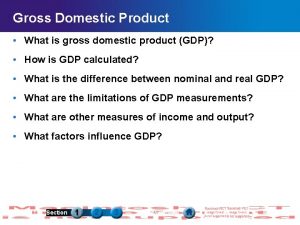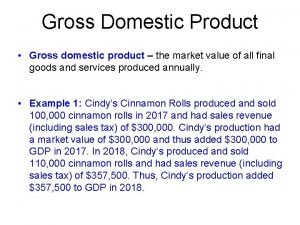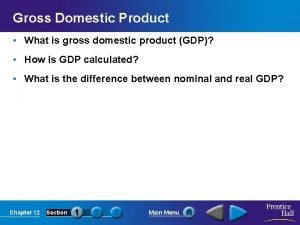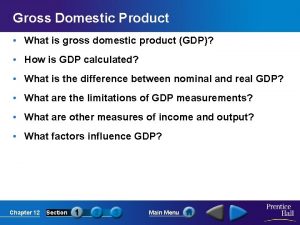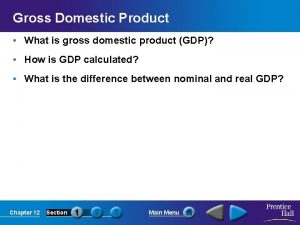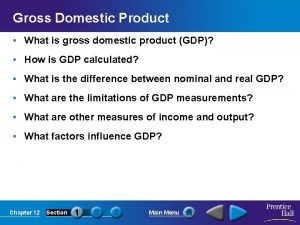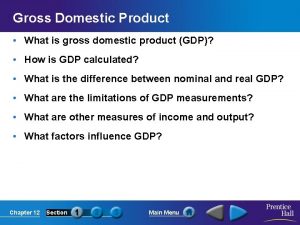National Output GDP GDP Gross DOMESTIC Product The
















- Slides: 16

National Output

GDP • GDP = Gross DOMESTIC Product – The dollar amount of all FINAL goods and services produced within a country’s boarders in a year – THE MOST IMPORTANT MEASURE OF THE ECONOMY’S OVERALL ECONOMIC PERFORMANCE – GDP good = economy good – GDP bad = economy bad

National Income Accounting • The system of statistics and accounts that keeps track of production, consumption, saving, and investment – Tracks overall economic performance • The data then is transferred to the U. S. Department of commerce through the National Income and Product Accounts (NIPA)

GDP, What Counts • Everything that is produced within the boarders of a country – Must be a final product • Even if the owner of the company is a foreign country – i. e. – Japanese cars made in factories within U. S. • But… – U. S. owned companies with factories in Mexico, Canada, or any other country does not

GDP, What Doesn’t Count? • Intermediate products – products used to make other products that are already counted in GDP – Tires for production cars – don’t count – Tires for sale at your local tire dealer – count • Second-Hand Sales – used goods – Used cars – Anything that is being sold for a second time • Nonmarket Transactions – transactions that take place out of the market – Doing work for yourself • Underground economy – unreported legal and illegal operations – Work that is done “under the table”

Products Quantity (Millions) Price (per 1 unit) Dollar Value (millions) Goods Automobiles Replacement Tires Shoes …* 6 10 55 …* $20, 000 $60 $50 …* $120, 000 $600 $2, 750 …* Services Haircuts Income Tax Filings Legal Advice …* 150 30 45 …* $8 $150 $200 …* $1, 200 $4, 500 $9, 000 …* Structures Single Family Multifamily Commercial …* 3 5 1 …* $75, 000 $300, 000 $1, 000 …* $225, 000 $1, 500, 000 $1, 000 …* Total Gross Domestic Product = $9 Trillion

Limitations • While measuring GDP, we are limited in knowing what the increase or decrease in output is resulting from – For example: GDP is reported as being up 10% • This seems good initially, but… • What if you learned that the increase was from the military producing bombs, nerve gas, or other forms of harmful products • Also, it tells us little about how the increase or decrease effects the quality of life

GNP • GNP – Gross National Product – Dollar value of all final goods, services, and structures produced in one year with labor and property supplied by a country’s residents • GNP is based on GDP, but with some small differences – GDP = Everything made and serviced here – GNP = Measures income of all Americans, inside or outside of our boarders • To go from GDP to GNP; must add all payments that Americans receive from outside the boarders, then subtract all payments made to foreign-owned resources in the U. S. GNP = GDP + American’s Income – Payments to foreign business

NNP • NNP = Net National Product – Includes the NIPA NNP = GNP-depreciation – Depreciation – the capital equipment that has worn out or become obsolete over the year

National Income (NI) • NI – the income that is left over after all taxes except the corporate profits tax are subtracted from NNP NI = NNP – Indirect business taxes and subsidies

Personal Income (PI) • PI – total amount of income going to consumers before individual income taxes are subtracted PI = NI + transfer payments to persons, personal interest income, and Social security receipts – undistributed corporate profits, corporate income taxes, and social security contributions

Disposable Income (DI) • DI – the total income the consumer sector has at its disposal after personal income taxes DI = PI – personal taxes and nontax payments

Economic Sectors • Consumer Sector (C) – largest sector in the macro economic structure • Household – all persons who occupy a house, apartment, or room that constitute separate living quarters • Includes – related family members, and all others – such as lodgers, foster children, and employees – who share living quarters

Economic Sectors – cont. • Investment Sector (I) – consists of businesses and investors • Includes – proprietorships, partnerships, and corporations • Responsible for bringing together the factors of production

Economic Sectors – cont. • Government Sector (G) – also known as the public sector • Includes all local, state, and federal levels of government

Output Expenditure Model • Used to show the aggregate demand by the consumer, investment, government, and foreign sectors. GDP = C+I+G+(X-M)
 Distinguish between gdp and gnp
Distinguish between gdp and gnp How many ways to calculate gdp
How many ways to calculate gdp Calculate gdp
Calculate gdp Whats included in gdp
Whats included in gdp Gross domestic product in a closed economy consists of
Gross domestic product in a closed economy consists of Measuring domestic output and national income
Measuring domestic output and national income Outputs
Outputs Measuring domestic output and national income
Measuring domestic output and national income Measuring domestic output and national income
Measuring domestic output and national income Difference between gdp gnp
Difference between gdp gnp Newly industrialized countries ap human geography
Newly industrialized countries ap human geography Paano sinusukat ang value added approach
Paano sinusukat ang value added approach Net exports formula
Net exports formula Apa itu npv
Apa itu npv What is included in gdp
What is included in gdp Nominal gdp
Nominal gdp Four pillars of gross national happiness
Four pillars of gross national happiness




